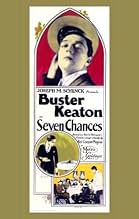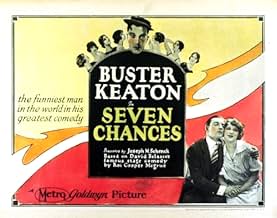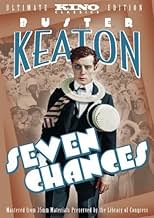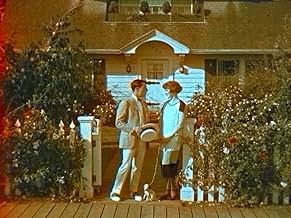IMDb-BEWERTUNG
7,8/10
12.464
IHRE BEWERTUNG
Ein Mann erfährt, dass er ein Vermögen erben wird, wenn er bis 19 Uhr an diesem Abend heiratet.Ein Mann erfährt, dass er ein Vermögen erben wird, wenn er bis 19 Uhr an diesem Abend heiratet.Ein Mann erfährt, dass er ein Vermögen erben wird, wenn er bis 19 Uhr an diesem Abend heiratet.
- Auszeichnungen
- 1 Gewinn & 1 Nominierung insgesamt
Frances Raymond
- Her Mother
- (as Frankie Raymond)
Jean Arthur
- Miss Smith - Office Receptionist
- (Nicht genannt)
Lori Bara
- Mother of Underage Girl
- (Nicht genannt)
Rosalind Byrne
- Hat Check Girl
- (Nicht genannt)
Louise Carver
- Prospective Bride Who Operates Crane
- (Nicht genannt)
Empfohlene Bewertungen
Contrary to what you may have read, "Seven Chances" (1925) was made before Buster Keaton signed with MGM and relinquished artistic control over his own films. His gifts of extraordinary agility, timing, and visualizing the comic potential in the most mundane situations are everywhere in evidence.
The plot of "Seven Chances" is ancient. A young bachelor stands to inherit millions if he can find a bride by a certain day and marry at a certain hour. The date is invariably the same as the day the will is read, and in the hands of Keaton, his writers and cast, the comic possibilities are brilliantly exploited. The same premise was the basis for at least three other films before Keaton's, and was remade (abysmally -- from what I've read) as "The Bachelor" with Chris O'Donnell in 1999. The chain of events that flows from news of the inheritance just builds and builds over the course of the film, the gags growing increasingly clever as time grows shorter. "Seven Chances" clocks in at less than an hour, but the final 15 minutes (which Buster Keaton reportedly reworked several times) are among the most hilarious in all of silent film, perhaps in the history of screen comedy.
Initially, only Buster, his business partner (T. Ray Brown) and the lawyer (Snitz Edwards, who was so terribly homely he was cute) are aware of the dilemma. After Buster botches a proposal to his longtime girlfriend, (Ruth Dwyer), he pops the question to several more female acquaintances, with predictably embarrassing results. It is then that Brown and Edwards (unbeknownst to Buster) decide to place a newspaper announcement advertising his plight.
Once the newspapers hit the streets, the chase is on. Keaton is pursued through 1920s Los Angeles by dozens, then scores, then seemingly hundreds of would-be brides. They come in all ages, shapes and sizes, makeshift veils trailing after them. No obstacle is too great in their pursuit to beat out each other for the prize of marriage to a man they don't even know, and Buster throws out plenty of roadblocks in his wake.
In 1979, Walter Kerr wrote the definitive book on silent comedies, "The Silent Clowns." One of the jacket blurbs reads, "I found myself laughing out loud at routines from movies I have never seen." I don't have Kerr's gift, but I can tell you that "Seven Chances" is the most consistently funny movie Buster Keaton ever made. All of his movies include inventive sight gags, but "Seven Chances," more than most of Buster's movies, relies on character comedy as well as situational comedy for its humor. And it scores a bull's eye on both. A sheer delight.
The plot of "Seven Chances" is ancient. A young bachelor stands to inherit millions if he can find a bride by a certain day and marry at a certain hour. The date is invariably the same as the day the will is read, and in the hands of Keaton, his writers and cast, the comic possibilities are brilliantly exploited. The same premise was the basis for at least three other films before Keaton's, and was remade (abysmally -- from what I've read) as "The Bachelor" with Chris O'Donnell in 1999. The chain of events that flows from news of the inheritance just builds and builds over the course of the film, the gags growing increasingly clever as time grows shorter. "Seven Chances" clocks in at less than an hour, but the final 15 minutes (which Buster Keaton reportedly reworked several times) are among the most hilarious in all of silent film, perhaps in the history of screen comedy.
Initially, only Buster, his business partner (T. Ray Brown) and the lawyer (Snitz Edwards, who was so terribly homely he was cute) are aware of the dilemma. After Buster botches a proposal to his longtime girlfriend, (Ruth Dwyer), he pops the question to several more female acquaintances, with predictably embarrassing results. It is then that Brown and Edwards (unbeknownst to Buster) decide to place a newspaper announcement advertising his plight.
Once the newspapers hit the streets, the chase is on. Keaton is pursued through 1920s Los Angeles by dozens, then scores, then seemingly hundreds of would-be brides. They come in all ages, shapes and sizes, makeshift veils trailing after them. No obstacle is too great in their pursuit to beat out each other for the prize of marriage to a man they don't even know, and Buster throws out plenty of roadblocks in his wake.
In 1979, Walter Kerr wrote the definitive book on silent comedies, "The Silent Clowns." One of the jacket blurbs reads, "I found myself laughing out loud at routines from movies I have never seen." I don't have Kerr's gift, but I can tell you that "Seven Chances" is the most consistently funny movie Buster Keaton ever made. All of his movies include inventive sight gags, but "Seven Chances," more than most of Buster's movies, relies on character comedy as well as situational comedy for its humor. And it scores a bull's eye on both. A sheer delight.
True love takes a lot of work - but this is ridiculous!
Jimmie Shannon (Buster Keaton) is a partner in a brokerage who can't quite bring himself to propose to Mary (Ruth Dwyer), the only woman he loves. Then, his business facing ruin, he discovers he stands to inherit a fortune if only he gets married that day. He proposes to Mary, but she's put off by his apparent insincerity. So Jimmie is left to find a woman, any woman, who will marry him. Will love prevail?
The film is an odd one for Keaton, starting off with a brief color sequence (in 1925) and moving quite slowly for Buster through the first third. The story was one Keaton had handed to him, rather than one he worked on himself, and feels at times like a "ladies' picture," focusing as it does on Jimmie's frustrated feelings and Mary's unhappiness.
For a while, Buster's not even the main laugh-getter in the film. For a while, he plays a kind of straight man to troll-visaged Snitz Edwards, playing the lawyer bringing the news of Jimmie's inheritance. Snitz chases after Jimmie and his partner, who think he's a process-server and dodge him, but Snitz prevails. Buster still pines for Mary, saying he can love no other woman (which she happens to hear over a telephone connection, changing her mind), but agrees to bring to bring a woman to church before the deadline out of loyalty to his partner.
"In case two show up, I'll marry the other," Snitz declares.
There are other oddities about "Seven Chances," like racial humor (Jimmie almost proposes to a black woman; a blackface actor plays a thick-headed hired hand) and the "Saphead"-style character Buster plays. It would seem like a lesser Keaton for that, but instead emerges as a masterwork of pacing and narrative. Just as you begin to settle in to "Seven Chances" tea-cozy aesthetic, it ramps things up for one of the great double-rally endings in movie history.
There's also a charming sequence where Jimmie tries to find a bride among a list of female members of his country club, the "seven chances" of the film's title. He burns through those chances in six minutes, and then gets rejected by a receptionist (Jean Arthur) and a hat-check girl (Rosalind Byrne) for good measure. The sequence plays with set design and framing to keep you always wondering as to what will happen next.
One amazing thing about the film you might not notice is the clever use of panning. Camera pans were still fairly new in cinema; framing was often stationary. But Buster is always in motion, and the camera moves with him. One clever shot, of Buster finding a turtle attached to his tie, apparently employs a treadmill in order to achieve an overhead camera angle.
The gags here keep coming, and give "Seven Chances" the feel of a classic Keaton short. Except there's a real story here to be told, and the humor always works to move the ideas forward. It's a classic demonstration of Keaton's ingenuity - even if he didn't have a hand in the film's conception or writing he directed it, and it shows - as well as his ability to find as many ways of making you laugh in as little time as possible.
Jimmie Shannon (Buster Keaton) is a partner in a brokerage who can't quite bring himself to propose to Mary (Ruth Dwyer), the only woman he loves. Then, his business facing ruin, he discovers he stands to inherit a fortune if only he gets married that day. He proposes to Mary, but she's put off by his apparent insincerity. So Jimmie is left to find a woman, any woman, who will marry him. Will love prevail?
The film is an odd one for Keaton, starting off with a brief color sequence (in 1925) and moving quite slowly for Buster through the first third. The story was one Keaton had handed to him, rather than one he worked on himself, and feels at times like a "ladies' picture," focusing as it does on Jimmie's frustrated feelings and Mary's unhappiness.
For a while, Buster's not even the main laugh-getter in the film. For a while, he plays a kind of straight man to troll-visaged Snitz Edwards, playing the lawyer bringing the news of Jimmie's inheritance. Snitz chases after Jimmie and his partner, who think he's a process-server and dodge him, but Snitz prevails. Buster still pines for Mary, saying he can love no other woman (which she happens to hear over a telephone connection, changing her mind), but agrees to bring to bring a woman to church before the deadline out of loyalty to his partner.
"In case two show up, I'll marry the other," Snitz declares.
There are other oddities about "Seven Chances," like racial humor (Jimmie almost proposes to a black woman; a blackface actor plays a thick-headed hired hand) and the "Saphead"-style character Buster plays. It would seem like a lesser Keaton for that, but instead emerges as a masterwork of pacing and narrative. Just as you begin to settle in to "Seven Chances" tea-cozy aesthetic, it ramps things up for one of the great double-rally endings in movie history.
There's also a charming sequence where Jimmie tries to find a bride among a list of female members of his country club, the "seven chances" of the film's title. He burns through those chances in six minutes, and then gets rejected by a receptionist (Jean Arthur) and a hat-check girl (Rosalind Byrne) for good measure. The sequence plays with set design and framing to keep you always wondering as to what will happen next.
One amazing thing about the film you might not notice is the clever use of panning. Camera pans were still fairly new in cinema; framing was often stationary. But Buster is always in motion, and the camera moves with him. One clever shot, of Buster finding a turtle attached to his tie, apparently employs a treadmill in order to achieve an overhead camera angle.
The gags here keep coming, and give "Seven Chances" the feel of a classic Keaton short. Except there's a real story here to be told, and the humor always works to move the ideas forward. It's a classic demonstration of Keaton's ingenuity - even if he didn't have a hand in the film's conception or writing he directed it, and it shows - as well as his ability to find as many ways of making you laugh in as little time as possible.
Jimmie Shannon (Buster Keaton) is a broker in need of money. When a lawyer comes to tell him he has inherited a certain sum, Jimmie avoids him thinking he may be bringing a summons. And then when he does hear the good news, there's a catch...
Directed by and starring Buster Keaton, this film portrays his particular brand of physical comedy, though perhaps not with as much danger as "The General" or as many tricks as "Sherlock Jr." The music of Robert Israel really carries this film. Not just because it's a silent film, but because it's great music -- moving, light and comedic. And there is an implied racial tone... Jimmie passes on proposing to both a Jew and a black woman.
I literally "laughed out loud" at this film! It is a shame Keaton considered it his worst film. Who knew it was so hard to get someone to marry you for $7,000,000 (in 1925 money, no less)?
Directed by and starring Buster Keaton, this film portrays his particular brand of physical comedy, though perhaps not with as much danger as "The General" or as many tricks as "Sherlock Jr." The music of Robert Israel really carries this film. Not just because it's a silent film, but because it's great music -- moving, light and comedic. And there is an implied racial tone... Jimmie passes on proposing to both a Jew and a black woman.
I literally "laughed out loud" at this film! It is a shame Keaton considered it his worst film. Who knew it was so hard to get someone to marry you for $7,000,000 (in 1925 money, no less)?
Buster Keaton catapults himself down a steep hillside, an avalanche of pebbles, rocks and boulders tumbling in his wake. If any one of these objects were to strike him down, he would certainly be killed by the impact. He is almost escaping the rocks now; just a few more seconds of frantic sprinting is required. Suddenly, Keaton looks up, only to find a massive horde of woman striding purposefully towards him. He is stuck between a rock and a hard place: an avalanche behind him, and a flock of would-be brides ahead. Quickly and delicately weighing his chances of survival either way, Keaton turns determinedly towards the barrage of boulders. It is hilarious little moments like this that make Buster Keaton's silent comedies such a joy to watch, and 'Seven Chances' is certainly one of the funniest I've seen, brimming with the talented actor's trademark deadpan humour.
The premise on which the story is based is singularly ridiculous, and so this allows Keaton to have a great deal of fun, placing his character in appropriately bizarre situations. Young Jimmy Shannon (Keaton) loves his sweetheart Mary Jones (Ruth Dwyer), but can never quite muster up the courage to tell her, and most certainly could never take that plunge into marriage. However, one day he discovers that his grandfather has left him the princely sum of $7 million, but only if he gets married by 7 PM that day! After he is rejected by Mary (due to an unfortunate misunderstanding), Jimmy seeks out another would-be bride, ultimately realising that finding a wife isn't as easy as he had hoped. The first half of the film is admittedly light on Keaton's patented stunt-work, but it remains a clever and witty situation comedy, with poor Jimmy suffering the laughter of onlookers as he moves from one girl to the next, tentatively asking for their hands in marriage.
When all this fails, an advertisement in the afternoon-edition newspaper brings hundreds of women to Jimmy's side, but by now he's realised that Mary is the only girl he could ever marry. As he struggles desperately to get to her home by 7:00, he is pursued by a horde of money-crazy ladies: big and small, young and old, beautiful and ugly. This is truly where Keaton comes into his element, and a hectic scramble down a hillside pursued by an avalanche of rocks is the film's most memorable moment {the idea for this scene came by accident, when Keaton inadvertently dislodged some rocks while he was running. The preview audience responded so favourably that he decided to re-shoot an extended sequence}. The paper-mâché rocks look quite convincing, and I was pretty much fooled into thinking that Keaten was really dodging the real thing (until I noticed him get bowled over by one of the boulders, without any apparent ill-effects!) 'Seven Chances' moves by at such a frenetic pace that there isn't a moment that could be trimmed. Though it runs for just 56 minutes, I had a huge smile on my face for every single one of them.
The premise on which the story is based is singularly ridiculous, and so this allows Keaton to have a great deal of fun, placing his character in appropriately bizarre situations. Young Jimmy Shannon (Keaton) loves his sweetheart Mary Jones (Ruth Dwyer), but can never quite muster up the courage to tell her, and most certainly could never take that plunge into marriage. However, one day he discovers that his grandfather has left him the princely sum of $7 million, but only if he gets married by 7 PM that day! After he is rejected by Mary (due to an unfortunate misunderstanding), Jimmy seeks out another would-be bride, ultimately realising that finding a wife isn't as easy as he had hoped. The first half of the film is admittedly light on Keaton's patented stunt-work, but it remains a clever and witty situation comedy, with poor Jimmy suffering the laughter of onlookers as he moves from one girl to the next, tentatively asking for their hands in marriage.
When all this fails, an advertisement in the afternoon-edition newspaper brings hundreds of women to Jimmy's side, but by now he's realised that Mary is the only girl he could ever marry. As he struggles desperately to get to her home by 7:00, he is pursued by a horde of money-crazy ladies: big and small, young and old, beautiful and ugly. This is truly where Keaton comes into his element, and a hectic scramble down a hillside pursued by an avalanche of rocks is the film's most memorable moment {the idea for this scene came by accident, when Keaton inadvertently dislodged some rocks while he was running. The preview audience responded so favourably that he decided to re-shoot an extended sequence}. The paper-mâché rocks look quite convincing, and I was pretty much fooled into thinking that Keaten was really dodging the real thing (until I noticed him get bowled over by one of the boulders, without any apparent ill-effects!) 'Seven Chances' moves by at such a frenetic pace that there isn't a moment that could be trimmed. Though it runs for just 56 minutes, I had a huge smile on my face for every single one of them.
This is a really sweet little Buster Keaton movie, with a greatly executed story.
Its story is fun enough to make the movie consistently a fun one. It's the sort of story that has copied a lot in movies ever since but also was used in movies before this one. It's even a popular subject for modern present day comedies. It perhaps makes "Seven Chances" seem less original than it in fact truly is of course.
The movie uses a lot of title cards. I mean, basically every line that gets spoken in the movie gets shown in a title card. It also makes the dialog part of the comedy of the movie. It isn't a much visual comedy, meaning that it doesn't really feature much slapstick or things like that. It's more a movie that relies on its comical situations and of course on the acting comical talent of Buster Keaton. Also the supporting cast is really more than great.
The movie begins a bit standard and perhaps even a bit slow but when the movie its story starts to take form the movie turns into one great laugh fest, with the last 20 minutes or so as the ultimate highlight, when things start to get really crazy and paced and the movie gets turned into one big non-stop comical chase! It's the one great fun moment after the other, with also some great and dangerous stunt work again from Buster Keaton himself!
A great Buster Keaton must-see, from the silent-era!
9/10
http://bobafett1138.blogspot.com/
Its story is fun enough to make the movie consistently a fun one. It's the sort of story that has copied a lot in movies ever since but also was used in movies before this one. It's even a popular subject for modern present day comedies. It perhaps makes "Seven Chances" seem less original than it in fact truly is of course.
The movie uses a lot of title cards. I mean, basically every line that gets spoken in the movie gets shown in a title card. It also makes the dialog part of the comedy of the movie. It isn't a much visual comedy, meaning that it doesn't really feature much slapstick or things like that. It's more a movie that relies on its comical situations and of course on the acting comical talent of Buster Keaton. Also the supporting cast is really more than great.
The movie begins a bit standard and perhaps even a bit slow but when the movie its story starts to take form the movie turns into one great laugh fest, with the last 20 minutes or so as the ultimate highlight, when things start to get really crazy and paced and the movie gets turned into one big non-stop comical chase! It's the one great fun moment after the other, with also some great and dangerous stunt work again from Buster Keaton himself!
A great Buster Keaton must-see, from the silent-era!
9/10
http://bobafett1138.blogspot.com/
Wusstest du schon
- WissenswertesBuster Keaton had this project foisted upon him by producer Joseph M. Schenck, who had bought the rights to the hit Broadway show. Keaton later called it his least favorite feature and tried to keep film historian Raymond Rohauer from restoring the only known copy of the movie.
- PatzerJust as the horde of would-be brides overruns the college football game, one of the players can be seen throwing himself to the ground, already pretending to be trampled.
- Zitate
Title Card: By the time Jimmie had reached the church, he had proposed to everything in skirts, including a Scotchman.
- VerbindungenFeatured in 4 Clowns (1970)
Top-Auswahl
Melde dich zum Bewerten an und greife auf die Watchlist für personalisierte Empfehlungen zu.
- How long is Seven Chances?Powered by Alexa
Details
- Erscheinungsdatum
- Herkunftsland
- Sprachen
- Auch bekannt als
- Buster Keaton - Seven Chances
- Drehorte
- Chatsworth, Los Angeles, Kalifornien, USA(train scene)
- Produktionsfirma
- Weitere beteiligte Unternehmen bei IMDbPro anzeigen
Box Office
- Weltweiter Bruttoertrag
- 268 $
- Laufzeit56 Minuten
- Farbe
- Sound-Mix
- Seitenverhältnis
- 1.33 : 1
Zu dieser Seite beitragen
Bearbeitung vorschlagen oder fehlenden Inhalt hinzufügen

Oberste Lücke
By what name was Der Mann mit den 1000 Bräuten (1925) officially released in India in English?
Antwort
![Trailer [OV] ansehen](https://m.media-amazon.com/images/M/MV5BNTUxNzY1MzYtN2MzMS00Yzc0LWIyNmMtYTE1ZmJhYTlkMDI4XkEyXkFqcGdeQXRyYW5zY29kZS13b3JrZmxvdw@@._V1_QL75_UX500_CR0)






























